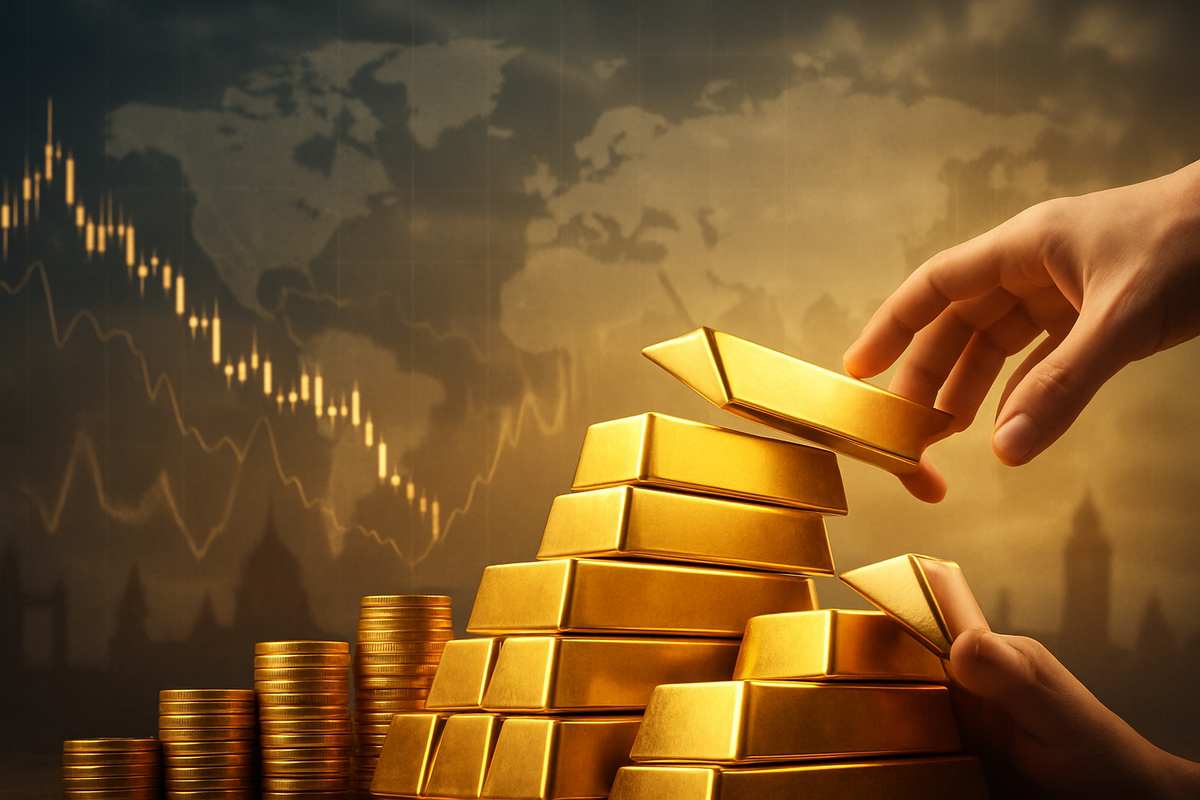
Gold, the age-old safe haven, has embarked on an unprecedented rally, shattering historical records and soaring past the $3,800 per ounce mark by early October 2025. This remarkable ascent has ignited a fierce debate across financial markets: Is this merely a symptom of escalating global anxiety, or does it signify a more fundamental and lasting shift in investment preferences, driven by profound geopolitical and economic forces? MarketMinute explores the factors propelling this golden surge and its far-reaching implications.
The precious metal's relentless climb reflects a complex interplay of persistent inflationary pressures, heightened geopolitical tensions, aggressive central bank gold accumulation, and a palpable shift in investor sentiment towards tangible assets. As global economies navigate a landscape fraught with uncertainty, gold's allure as a store of value has never been stronger, prompting investors and central banks alike to re-evaluate its crucial role in diversified portfolios.
The Relentless Ascent: A Timeline of Gold's Historic Surge
The current gold rally is not a sudden phenomenon but the culmination of trends that began in late 2024 and accelerated dramatically throughout 2025. Gold prices, which had already seen a robust 25% gain in 2024, closing near US$2,778 per ounce, continued their upward trajectory with renewed vigor.
The metal broke through the significant $2,900/oz barrier in February 2025, a psychological milestone that fueled further momentum. March 2025 witnessed another historic moment as gold surpassed the US$3,000 per ounce mark for the first time ever. By April, prices peaked at an astonishing $3,500/oz, driven by unpredictable U.S. trade policies and a backdrop of escalating global tensions. The momentum didn't wane; May 2025 saw reports of gold trading above $3,932/oz. Most recently, by September 2025, gold surged past $3,860 per ounce, propelled by safe-haven demand amidst U.S. government shutdown concerns, stable inflation data, and anticipation of further Federal Reserve easing. As of October 3, 2025, gold was trading robustly around $3,894 to $3,901 per ounce, reaching an all-time high of $3,897.31. This impressive 45% year-to-date gain in 2025 marks its strongest annual performance since 1979, making it a standout performer in a volatile market.
Key players driving this surge include global central banks, which have been on an unprecedented gold-buying spree, accumulating over 1,000 tonnes annually from 2022-2024 and projected to exceed 1,300 tonnes in 2025. This institutional demand, coupled with robust retail and institutional investor inflows into gold Exchange Traded Funds (ETFs) – reportedly up 20% in 2025 – underscores a collective flight to safety and a desire for portfolio diversification. Initial market reactions have been characterized by a notable shift of capital from riskier assets into gold, signaling a pervasive sense of caution among investors.
Corporate Fortunes: Winners and Losers in the Golden Era
Gold's unprecedented rally naturally creates distinct winners and losers across the corporate landscape. Companies directly involved in gold mining and precious metals stand to benefit immensely, while others might face headwinds from the underlying economic conditions driving gold's rise.
Potential Winners: Gold mining companies are experiencing a significant boost to their revenues and profitability. Higher gold prices directly translate to increased margins, assuming production costs remain relatively stable. Major players like Barrick Gold (NYSE: GOLD) and Newmont (NYSE: NEM) are poised to report record earnings, allowing them to fund new exploration, pay down debt, or return capital to shareholders through dividends and buybacks. Smaller, high-cost producers might also find renewed viability in this elevated price environment. Companies specializing in gold streaming and royalty agreements, such as Franco-Nevada (NYSE: FNV), also benefit directly from higher commodity prices without incurring the operational costs and risks of mining. Furthermore, investment vehicles like gold-backed Exchange Traded Funds (ETFs) such as SPDR Gold Shares (NYSEARCA: GLD) have seen substantial inflows, increasing their assets under management and potentially their fee income.
Potential Losers/Affected: Conversely, companies highly sensitive to inflation could face challenges. Businesses with significant input costs for raw materials, energy, or labor may struggle to pass these increased costs onto consumers, squeezing profit margins. Consumer discretionary companies (e.g., retail, leisure) might see reduced demand as consumers grapple with higher prices for essential goods and services, leading to a tightening of household budgets. Financial institutions, particularly those with exposure to highly leveraged assets or volatile equity markets, could experience increased risk if gold's rally truly signals deeper economic instability or a sustained period of high inflation and interest rate uncertainty. Additionally, a strong gold price often correlates with a weaker U.S. dollar, which can impact multinational corporations with significant international operations, affecting their currency translation and competitiveness in global markets.
Broader Implications: A Shift in the Global Financial Order
The gold rally extends beyond mere price movements; it reflects and contributes to several broader industry trends and potential shifts in the global financial order. It highlights the deepening mistrust in fiat currencies and traditional financial systems, particularly amidst unprecedented global debt levels and persistent inflationary pressures.
One of the most significant trends is the ongoing de-dollarization effort by central banks worldwide. The aggressive accumulation of gold by central banks, particularly from emerging economies, signals a deliberate strategy to diversify reserves away from the U.S. dollar, reducing reliance on a single currency for international trade and finance. This trend has significant ripple effects on currency markets, potentially contributing to a weaker U.S. dollar and strengthening other currencies or commodity-backed assets. The gold rally also underscores persistent geopolitical instability, with renewed sanctions on Iran, Eastern European tensions, and unpredictable U.S. trade policies driving investors towards gold as a hedge against sovereign risk.
Historically, gold rallies have often coincided with periods of significant economic or political upheaval. The 1970s, marked by high inflation and geopolitical shocks, saw gold prices soar. Similarly, the post-2008 financial crisis era saw a strong appreciation for gold as investors sought safety. The current rally draws parallels, suggesting a similar environment of profound uncertainty. Regulatory and policy implications could include increased scrutiny of central bank gold policies, debates around currency stability, and potentially new international agreements aimed at stabilizing global financial markets if the current trends persist and lead to greater instability.
What Comes Next: Navigating the Golden Future
The path forward for gold and the markets it influences is complex, with both short-term volatility and long-term strategic shifts on the horizon. Investors and businesses must prepare for a landscape where gold plays an increasingly central role.
In the short-term, gold prices may experience periods of consolidation or profit-taking, especially if any of the underlying drivers (geopolitical tensions, inflation data) show temporary signs of easing. However, the strong institutional and central bank demand provides a robust floor, suggesting that any significant pullbacks might be viewed as buying opportunities. The ongoing U.S. government shutdown concerns and anticipation of further dovish stances from the Federal Reserve are likely to keep gold well-supported.
Long-term, if the current trends of persistent global uncertainty, elevated inflation, and central bank diversification continue, gold is poised to remain a core component of investment portfolios. It could solidify its position not just as a safe haven but as a fundamental asset for wealth preservation in an era of currency debasement concerns. This might necessitate strategic pivots for traditional asset managers, potentially increasing their allocation to precious metals and related equities. For companies, especially those with international operations, hedging strategies against currency fluctuations and commodity price volatility will become even more critical.
Market opportunities will likely emerge in the mining sector, gold-backed financial products, and potentially in countries with significant gold reserves looking to leverage their assets. Conversely, challenges may arise for growth-oriented stocks if capital continues to flow into defensive assets like gold, potentially leading to a re-rating of valuations across different sectors. Potential scenarios range from a continued, albeit volatile, ascent towards new price targets (some analysts project $4,000 to $5,000 per ounce) to a more stable, higher trading range if global conditions find a new equilibrium.
Comprehensive Wrap-Up: Gold's Enduring Significance
Gold's unprecedented rally to record highs in late 2024 and throughout 2025 is more than just a market anomaly; it's a powerful signal from the global financial system. The key takeaways from this event underscore gold's enduring role as a hedge against inflation, a safe haven during geopolitical turmoil, and a strategic asset for central banks seeking to diversify their reserves.
Moving forward, the market is likely to remain characterized by elevated uncertainty. The confluence of factors driving gold's ascent—from persistent inflation and massive global debt to escalating geopolitical conflicts and central bank de-dollarization—suggests that these are not transient issues. Gold's performance reflects a deep-seated anxiety about the stability of traditional financial instruments and global economic order. This event signifies a lasting impact, potentially ushering in a new era where gold is viewed less as a cyclical commodity and more as a foundational pillar of global financial stability.
Investors should closely watch several key indicators in the coming months: further geopolitical developments, particularly in Eastern Europe and the Middle East; global inflation data and the corresponding responses from major central banks (especially the Federal Reserve's interest rate policies); and the continued strength or weakness of the U.S. dollar. The sustained demand from central banks will also be a critical barometer. Gold's golden age appears to be far from over, demanding a thoughtful and adaptive approach from all market participants.
This content is intended for informational purposes only and is not financial advice






